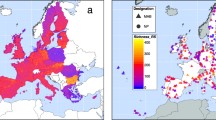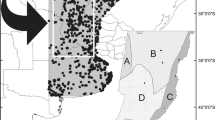Abstract
The Bonelli’s eagle (BE) is considered by the European Union as a high-priority species for conservation in the Valencian Community (East of Spain). However, in 2006 the European Union opened a legal procedure against the Spanish Kingdom, accused of lacking of an adequate network of special protected areas (SPAs) to preserve the BE in the region. Here we evaluate whether important bird areas (IBAs) and SPAs network is enough to preserve this species, on the basis of a thorough analysis of habitat preferences. A GAP analysis is performed to conduct a revision of current SPAs and BirdLife proposed IBAs. Our results suggest that the current network of SPAs becomes insufficient to protect the BE. The IBAs network, although improves the current network of SPAs, increasing the percentage of BE potential habitat included, also results inadequate. We propose a new SPAs network according to the potential suitable habitat for the species. Given the trade-off between financial investment and the conservation of biodiversity, we propose to maximize the surface of potential habitat included in the protected network minimizing the surface of the region that would be necessary to protect, thus avoiding an unnecessary expense and otherwise unrealistic results.













Similar content being viewed by others
References
Andelman SJ, Fagan WF (2000) Umbrellas and flagships: efficient conservation surrogates or expensive mistakes?. Proc Natl Acad Sci USA 97:5954–5959
Araujo MB (2004) Matching species with reserves–uncertainties from using data at different resolutions. Biol Conserv 118:533–538
Argos (1996) User’s manual. CLS/Service Argos, Toulouse
BirdLife (2004a) Birds in Europe: population estimates, trends and conservation status. BirdLife International, Cambridge
BirdLife (2004b) Species factsheet: Hieraaetus fasciatus. BirdLife International, Cambridge
Burley F (1988) Monitoring biological diversity for setting priorities in conservation. In: Wilson E (ed) Biodiversity. National Academy Press, Washington, pp 227–230
Carroll C, Noss RF, Paquet PC (2001) Carnivores as focal species for conservation planning in the Rocky Mountain region. Ecol Appl 11:961–980
De Klerk HM, Fjeldsa J, Blyth S, Burgess ND (2004) Gaps in the protected area network for threatened Afrotropical birds. Biol Conserv 117:529–537
Del Moral JC (2006) El águila perdicera en España. Población en 2005 y método de censo. SEO/BirdLife, Madrid
Dietz RW, Czech B (2005) Conservation deficits for the continental United States: an ecosystem gap analysis. Conserv Biol 19:1478–1487
Encarta-online (2006) “Valencian Community”, In Microsoft© Encarta© Encyclopedia online 2006. 1997–2006 ©Microsoft Corporation
ESRI (1999) ArcView GIS 3.2. Environmental Systems Research Institute Inc. 1992–1999, New York
Fjeldsa J, Burgess ND, Blyth S, de Klerk HM (2004) Where are the major gaps in the reserve network for Africa’s mammals? Oryx 38:17–25
Groom M, Gary KM, Ronald CC (2006) Principles of conservation biology, 3rd edn. Sinauer Associates, Sunderland
Guisan A, Zimmermann NE (2000) Predictive habitat distribution models in ecology. Ecol Modell 135:147–186
Hosmer DW, Lemeshow S (2000) Applied logistic regression analysis, 2nd edn. Wiley, New York
Keating KA, Cherry S (2004) Use and interpretation of logistic regression in habitat selection studies. J Wildl Manage 68:774–789
Keating KA, Brewster WG, Key CH (1991) Satellite telemetry–performance of animal-tracking systems. J Wildl Manage 55:160–171
Kenward R (2001) A manual for wildlife radio tagging. Academic, San Diego
Kerr JT (1997) Species richness, endemism, and the choice of areas for conservation. Conserv Biol 11:1094–1100
Kirkpatrick JB (1983) An iterative method for establishing priorities for the selection of nature reserves–an example from Tasmania. Biol Conserv 25:127–134
López-López P, García-Ripollés C, Aguilar JM, García-López F, Verdejo J (2006) Modelling breeding habitat preferences of Bonelli’s eagle (Hieraaetus fasciatus) in relation to topography, disturbance, climate and land use at different spatial scales. J Ornithol 147:97–106
López-López P, García-Ripollés C, Urios V (in press a) Population size, breeding performance and territory quality of Bonelli’s eagle (Hieraaetus fasciatus) in eastern Iberian Peninsula. Bird Study
López-López P, García-Ripollés C, Soutullo Á, Cadahía L, Urios V (in press b) Identifying potentially nesting habitat for golden eagles (Aquila chrysaetos) applied to Important Bird Areas design. Anim Conserv
Maiorano L, Falcuccia A, Boitani L (2006) Gap analysis of terrestrial vertebrates in Italy: priorities for conservation planning in a human dominated landscape. Biol Conserv 133:455–473
Manly BFJ, McDonald L, Thomas DL, McDonald T, Erickson WP (2002) Resource selection by animals: statistical design and analysis for field studies, 2nd edn. Kluwer Academic Publishers, Dordrecht
Meffe G, Ronald C (1997) Principles of conservation biology. Sinauer Associates, Sunderland
Murphy DD, Noon BR (1992) Integrating scientific methods with habitat conservation planning–reserve design for northern spotted owls. Ecol Appl 2:3–17
Newton I (1979) Population ecology of raptors. T & AD Poyser, Berkhamstead, UK
Oldfield TEE, Smith RJ, Harrop SR, Leader-Williams N (2004) A gap analysis of terrestrial protected areas in England and its implications for conservation policy. Biol Conserv 120:303–309
Pearce J, Ferrier S (2000) Evaluating the predictive performance of habitat models developed using logistic regression. Ecol Modell 133:225–245
Pressey RL (1994) Ad hoc reservations–forward or backward steps in developing representative reserve systems. Conserv Biol 8:662–668
Primack RB (2000) A primer of conservation biology, 2nd edn. Sinauer, Sunderland
Pullin AS (2004) Conservation biology. Cambridge University Press, Cambridge
Real J (2004) Águila-azor perdicera, Hieraaetus fasciatus. In: Madroño A, González C, Atienza JC (eds) Red book of the birds of Spain. Libro Rojo de las Aves de España. Dirección General para la Biodiversidad-SEO/Birdlife, Madrid, pp 154–157
Rodrigues ASL, Tratt R, Wheeler BD, Gaston KJ (1999) The performance of existing networks of conservation areas in representing biodiversity. Proc R Soc Lond Ser B Biol Sci 266:1453–1460
Rodrigues ASL, Andelman SJ, Bakarr MI, Boitani L, Brooks TM, Cowling RM, Fishpool LDC, da Fonseca GAB, Gaston KJ, Hoffmann M, Long JS, Marquet PA, Pilgrim JD, Pressey RL, Schipper J, Sechrest W, Stuart SN, Underhill LG, Waller RW, Watts MEJ, Yan X (2004) Effectiveness of the global protected area network in representing species diversity. Nature 428:640–643
Scott JM, Csuti B, Jacobi JD, Estes JE (1987) Species richness–a geographic approach to protecting future biological diversity. Bioscience 37:782–788
Scott JM, Davis F, Csuti B, Noss R, Butterfield B, Groves C, Anderson H, Caicco S, Derchia F, Edwards TC, Ulliman J, Wright RG (1993) Gap analysis–a geographic approach to protection of biological diversity. Wildl Monogr 121:1–41
Scott JM, Davis FW, McGhie RG, Wright RG, Groves C, Estes J (2001) Nature reserves: do they capture the full range of America’s biological diversity? Ecol Appl 11:999–1007
SEO (2006a) Luxembourg judges Spain for insufficient SPA. Luxemburgo juzga a España por insuficientes ZEPA La Garcilla 127:39
SEO (2006b) The Luxembourg Council considers insufficient the Spanish SPA network. El Tribunal de Luxemburgo considera insuficiente la red de ZEPA del estado español. La Garcilla 128:47
Sergio F, Newton I, Marchesi L (2005) Top predators and biodiversity. Nature 436:192–192
Sergio F, Newton I, Marchesi L, Pedrini P (2006) Ecologically justified charisma: preservation of top predators delivers biodiversity conservation. J Appl Ecol 43:1049–1055
Sokal RR, Rohlf FJ (1981) Biometry. Freeman WH and Company, New York
Soutullo Á, Cadahía L, Urios V, Ferrer M, Negro JJ (in press) Accuracy of lightweight satellite telemetry: a case study in the Iberian Peninsula. J Wildl Manage
StatSoft (2004) STATISTICA (data analysis software system), version 7. StatSoft Incorporated, Tulsa
Steenhof K, Kochert MN (1982) An evaluation of methods used to estimate raptor nesting success. J Wildl Manage 46:885–893
Sutherland WJ, Green RE (2004) Habitat assessment. In: Sutherland WJ, Newton I, Green RE (eds) Bird ecology and conservation. Oxford University Press, Oxford, pp 251–268
Viada C (1998) Áreas Importantes para las Aves en España. Monografía n° 5. SEO/BirdLife, Madrid
Yip JY, Corlett RT, Dudgeon D (2004) A fine-scale gap analysis of the existing protected area system in Hong Kong, China. Biodivers Conserv 13:943–957
Acknowledgments
We would like to thank F. García-López, J.M. Aguilar and J. Verdejo for helping in the fieldwork and their valuable suggestions about raptor biology. We also thank P. Mateache, J. Jimenez and E. Rodríguez of the Conselleria de Territori i Habitatge of the Generalitat Valenciana for their support and GIS assistance. We are grateful to E. Barba for his support and confidence. P. López-López and L. Cadahía are supported by FPU grants of the Spanish Ministerio de Educación y Ciencia (references AP2005-0874 and AP2001-1444, respectively). All the research was compliant with all the laws of Spain where it was conducted. This paper is a part of P. López-López PhD thesis.
Author information
Authors and Affiliations
Corresponding author
Rights and permissions
About this article
Cite this article
López-López, P., García-Ripollés, C., Soutullo, Á. et al. Are important bird areas and special protected areas enough for conservation?: the case of Bonelli’s eagle in a Mediterranean area. Biodivers Conserv 16, 3755–3780 (2007). https://doi.org/10.1007/s10531-007-9179-1
Received:
Accepted:
Published:
Issue Date:
DOI: https://doi.org/10.1007/s10531-007-9179-1




